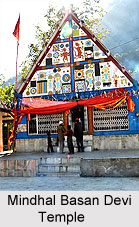 Mindhal Basan Devi Temple is a remarkably honored shrine, placed in Pangi Valley, Chamba in the state of Himachal Pradesh. The Pangi Valley is located in the upper part of Chamba. Pangi is perhaps the most arresting spot in Himachal Pradesh. The Pangi Valley has the famous pent-rooted and richly carved temple dedicated to the goddess popularity known as Mindhal Devi. The Devi is regarded to have revealed herself as a black stone in the hearth of woman whose house stood where the temple now is. Mindhal Devi temple is also known for its dainty woodcarvings. The temple has a slanting tin roof. Mindhal Devi Temple is a vast pilgrim centre for the Pangwals, people who worship the goddess for better crops and fate. The Mindhal Devi Temple is situated 12km from Pangwal in Pangi Valley.
Mindhal Basan Devi Temple is a remarkably honored shrine, placed in Pangi Valley, Chamba in the state of Himachal Pradesh. The Pangi Valley is located in the upper part of Chamba. Pangi is perhaps the most arresting spot in Himachal Pradesh. The Pangi Valley has the famous pent-rooted and richly carved temple dedicated to the goddess popularity known as Mindhal Devi. The Devi is regarded to have revealed herself as a black stone in the hearth of woman whose house stood where the temple now is. Mindhal Devi temple is also known for its dainty woodcarvings. The temple has a slanting tin roof. Mindhal Devi Temple is a vast pilgrim centre for the Pangwals, people who worship the goddess for better crops and fate. The Mindhal Devi Temple is situated 12km from Pangwal in Pangi Valley.
Legend of Mindhal Basan Devi Temple
The spot where the temple stands was originally occupied by a house, consisting of an upper and lower storey, as is usual in Pangi, belonging to a widow with seven sons. One day in early autumn while she was cooking in the upper storey, a black stone appeared in the chulah (hearth) causing her much annoyance. She tried to beat it down but in vain. At last she was seized with a trembling, and thus knew that the stone was a Devi. Rushing outside she called her sons, who were ploughing in a field with two oxen to a plough, and told them that a Devi had appeared in the house. They made light of the matter and asked tauntingly if the Devi would enable them to plough with one ox or give them a sasan, Immediately, the widow and her sons were turned to stone, she in the house and they in the field. From that time only one ox to a plough has been used in ploughing at Mindhal and the place has been a "sasan" grant for many centuries. People believe that if two oxen are used for plugging, one of them will die. "Sasan" stands for revenue-free grant of land which the temple enjoyed for centuries.
Festival at Mindhal Basan Devi Temple
The annual fair, held in the month of Bhado, fetches a great number of people from all over the valley. Umpteen sheep and goats are ritually sacrificed on this event as offerings to the deity. It is believed that blood of the sacrificed livestock flows through a hole at the temple door to a pool at the foot of Kulal Village, thus giving it a hint of red.





















